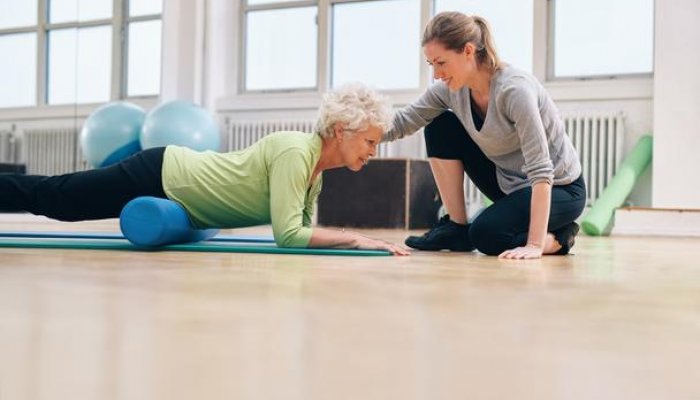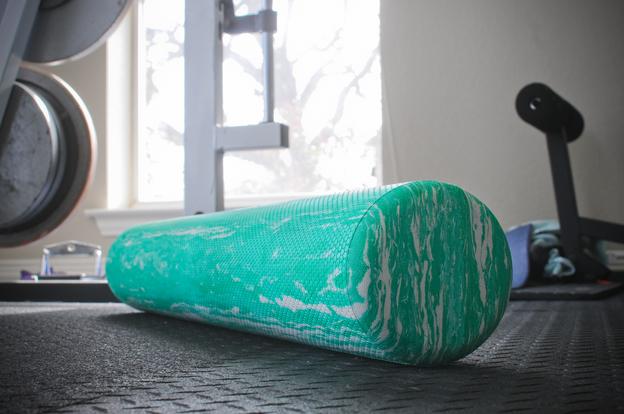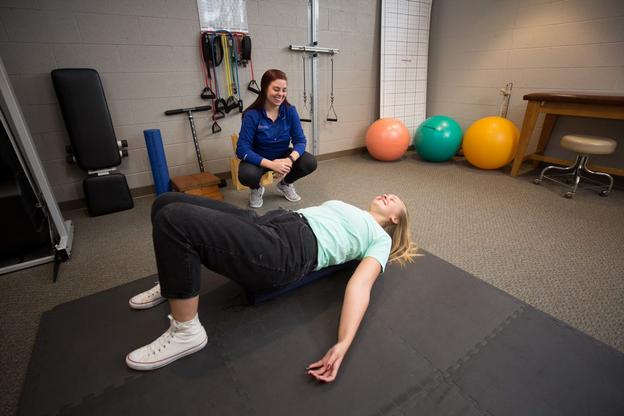You Can Benefit From Using a Foam Roller

Are you limited in your motion and even your willingness to exercise because of muscle tightness or soreness? Foam rolling reduces muscle tension so that you can get moving and strengthen your weak areas again.
Do you feel like you may be too old to move like you used to? We recommend foam rolling. You can restore integrity to your muscles and other soft tissues. You’re not too old! You may just be too tight.
Self-Myofascial Release
When you use a foam roller you are doing something called self-myofascial release (SMR).
What’s self-myofascial release, you ask? You know that good hurt you feel when getting a massage, particularly a sports massage or deep tissue massage? That hurts-so-good feeling happens when tight spots and tender spots get the attention they need.
Your muscles are targeted by your masseuse at their weakest and knottiest places, worked on, and loosened up. It may feel slightly uncomfortable at times, but you know that there is goodness coming.That goodness is a looseness and a lengthening of your muscles that helps your overall posture and mobility.
Even though we can’t afford a personal masseuse on a
daily basis, we can learn to help ourselves out
Foam rolling can make you feel the same way! You can get the benefit of massage without paying for it and whenever you need it by learning how to use a foam roller.
What’s more, you can get an even greater benefit than a massage because you are in control of the pressure and location of the force used.
When you foam roll, you can spend more time where it is needed and work it as gently or as deeply as you want.
How does self-myofascial release work?
Our muscles are connected to and surrounded by fascia - the layer of connective tissue that runs throughout our body in one continuous sheet. Fascia tissue, like muscles, also gets bunched up and knotted up in places. Sometimes these are called trigger points.
These dense areas of tissue are tender to the touch because they are unhealthy. They are pulling on other tissue and making things generally uncomfortable. Putting the appropriate pressure on the “trigger points” breaks up the adhesions and restrictions in the fascia and muscles.

How does foam rolling do this?
The foam roller is used as a firm point of contact for your body and your body weight provides the pressure needed. You decide how much pressure by stabilizing yourself with your hands, elbows, knees, and/or feet on the ground.
The pressure of your body weight compresses the soft tissue, forcing a contraction, and then it releases, allowing the tissue to loosen up, adhesions to break up, and blood to circulate again throughout the area.
Typically you spend about a minute in a given area, moving back and forth slowly and pausing where it feels most tender until the tissue “lets go.” This is when adhesions are letting go and the muscle fibers are able to move more freely.
Part of the healing to the area comes because blood circulation increases into the area. The rush of blood both brings nutrients and carries away toxins.
Should I use a foam roller?
Most everyone can benefit from foam rolling. If you are able to get down on the floor and use your body to move on the foam roller with the support of your arms and legs, you can do it. The most sedentary person can benefit tremendously because his muscles are weak and tight from lack of use.
Professional athletes like Tom Brady swear by foam rolling to keep their muscles pliable and able to respond to extreme use. Any athlete’s muscles need help relaxing after strenuous exertion and foam rolling helps muscles release tension.In other words, just about all of us can benefit from learning to use a foam roller on a regular basis.
The Right Foam Roller
Choosing the right foam roller is important. They come in low, medium, and high density.
- High-density is best for those who are quite muscular and have lots of soft tissue to work on
- Medium-density is good for most people
- Low-density is good for those who are in rehab after an injury or have sensitivities to intense pressure
You can purchase them online if you need one.

Before, After, OR As Exercise?
Learning to use a foam roller provides you with a very powerful tool at home to deal with your muscle aches and pains.
Foam rolling is a great way to warm up your muscles before you exercise. It’s also a helpful way to release tension and tightness in muscles that need it after a workout.
Not even ready for a workout? Muscles too tight to even go for a walk? Inflammation and trigger points can keep you in a sedentary lifestyle - even though that’s the last thing you need. Using a foam roller to work through all of your muscle and fascia tightness is a great thing to do SO THAT you can get moving and have a regular workout routine.
Concerned About Injury or Re-Injury?
When our fascia and muscles are in a taut position they are not only painful. They are set up for injury. Using a foam roller to regularly loosen up before a workout can help prevent injury.
How To’s
- The idea in foam rolling is to apply pressure to a muscle using your body weight.
- You want to move at a slow pace, moving gently back and forth over an area maybe 6 to 10 inches long, slowing and pausing where it feels uncomfortable (like it needs a good stretch) but not terrible pain.
- Avoid bones and the lower back.
- Stay in an area about a minute total and move on.
- Relax as much as possible and remember to breathe deeply throughout the stretch. This makes all of your effort much more effective to get a deep stretch.
You may feel some soreness the next day. That is normal. But you should also feel looser in your body.
Where Should I Start?
Looking for some basic instruction? Check out this 5 Minute Routine.
Shane, the trainer in the video, walks you through using a foam roller throughout the body in 6 different movements. The video is about 10 minutes but the routine should be about 5 minutes once you learn it.
Her notes on these 6 movements are as below:
1. Quadriceps
Start with both legs on the roller and your elbows on the floor. Start slowly rolling up and down the muscle tissue, using your arms to stabilize and roll yourself up and down the roller. If you locate a spot that is tender don’t antagonize it by staying for too long. Take a deep breath and allow your muscle to relax into the roller, then continue rolling up and down.
2. TFL/Lateral Quad
Your Tensor Fascia Latae is a small muscle near the outer hip and one main duty is to stabilize the hip and pelvis. You will need to position to foam roller to the outside of the hip, so rolling one leg at a time may be easier. Start with rolling at the top of the hip then roll to the lateral (outside) part of your quadriceps complex and position roller up towards your hip and roll down towards the knee.
3. Gluteus Medius/Maximus
You can sit on the roller and cross one leg over the other. Roll to the gluteus medius of the leg that is cross on top. Remember to roll soft tissue and gently roll up and down the muscle(s).
4. Calves (Gastrocnemius & Soleus)
You can start with both legs on the roller or cross one on top. You can use your hands to gently lift your hips off the floor and roll up and down your calf muscle. You can also keep your hips on the floor and position to roller just below your gastrocnemius, on your soleus and do ankle circles to the right and left.
5. Upper Back (Between your Scapula)
Start with making sure your head and neck are supported with your hands and position the roller in the middle of your back, making sure to not roll towards your lower ribs. Lift your hips off the floor and use your feet to roll your body up and down the roller, gently rolling from mid back to your upper back between your scapula (shoulder blades).
6. Snow Angels (Pectoralis Major/Minor and Anterior Deltoid)
Sit on the very end of the roller and roll down so you have placed the roller along your spine. Make sure your head is resting on the roller. Bend your knees so your feet are stable on the floor to help you balance. Open your arms up to a T position with your palms facing up to the ceiling. Start to reach your arms overhead and then down towards your hips in a slow, sweeping motion.

Come See Us
If you are in pain and not making good progress at home, give us a call. We are seeing patients in our clinic, taking all precautions necessary.
At Daniels Chiropractic we can get your spine back into its normal position and increase its mobility. We can also design a stretching and exercise plan for you to practice at home.
We are committed to helping you feel, move, and live better. Give us a call at 262.638.9999 to make an appointment.
Daniels Chiropractic Office
2609 Rapids Drive
Racine, WI 53404
Phone: 262.638.9999
Fax: 262.638.0742
